James DiEugenio tracks the FBI boss and his renegade violence against any sign of a Black Messiah through two current films.

Martin Luther King Jr., front row & second from left, at March on Washington, Aug, 28, 1963. (U.S. National Archives and Records Administration, Wikimedia Commons)
By James DiEugenio
Special to Consortium News
 In the late afternoon of April 4, 1968, in Memphis, Martin Luther King Jr. was preparing to go to dinner with some friends. As he stepped out onto the balcony of his room at the Lorraine Motel, he was killed by an assassin’s bullet that struck him in the cheek.
In the late afternoon of April 4, 1968, in Memphis, Martin Luther King Jr. was preparing to go to dinner with some friends. As he stepped out onto the balcony of his room at the Lorraine Motel, he was killed by an assassin’s bullet that struck him in the cheek.
In the pre-dawn hours of Dec. 4, 1969, in Chicago, a drugged Fred Hampton was wounded in his sleep during a police raid on his rented apartment. He was then killed by two more bullets, after which — according to Hampton’s fiancee, Debra Johnson who was on the scene — the officer said, “He’s good and dead now.”
The arc drawn between those two murders outlines more than the death of those two men. In effect it was the end of what was known as the black activist movement. The project that King was working on at the time of his death, the Poor People’s March, ended as a tragic failure. The Black Panther movement was deprived of the member who many thought had the greatest potential for leadership. King was 39. Hampton was 21.
Two new films, one a documentary and one a feature film, now depict the careers and demises of Hampton and King. But Judas and the Black Messiah by Shaka King and MLK/FBI by Sam Pollard go further than that. They attempt to show the reasons behind their deaths.
In both films, with much justification, the finger of guilt points towards FBI Director J. Edgar Hoover. No one knows why Hoover had a phobia towards any kind of strong leadership that would galvanize the grievances of black Americans. But there is no doubt he did. It extended back for decades, even before he became FBI director.
As part of the General Intelligence Division, which surveilled radical groups, Hoover’s first African-American target was black nationalist Marcus Garvey. One of the tactics he used, as he would later against King and Hampton, was infiltrating Garvey’s organization with agents of Garvey’s own race.
As time went on, Hoover’s pathology on the subject did not subside. If anything, it increased. But it now co-mingled with another perceived menace, namely communism. For instance, according to Kenneth O’Reilly, in his book Racial Matters, in Hoover’s eyes, the terrible Detroit race riot of 1943 was caused by communist agitation.
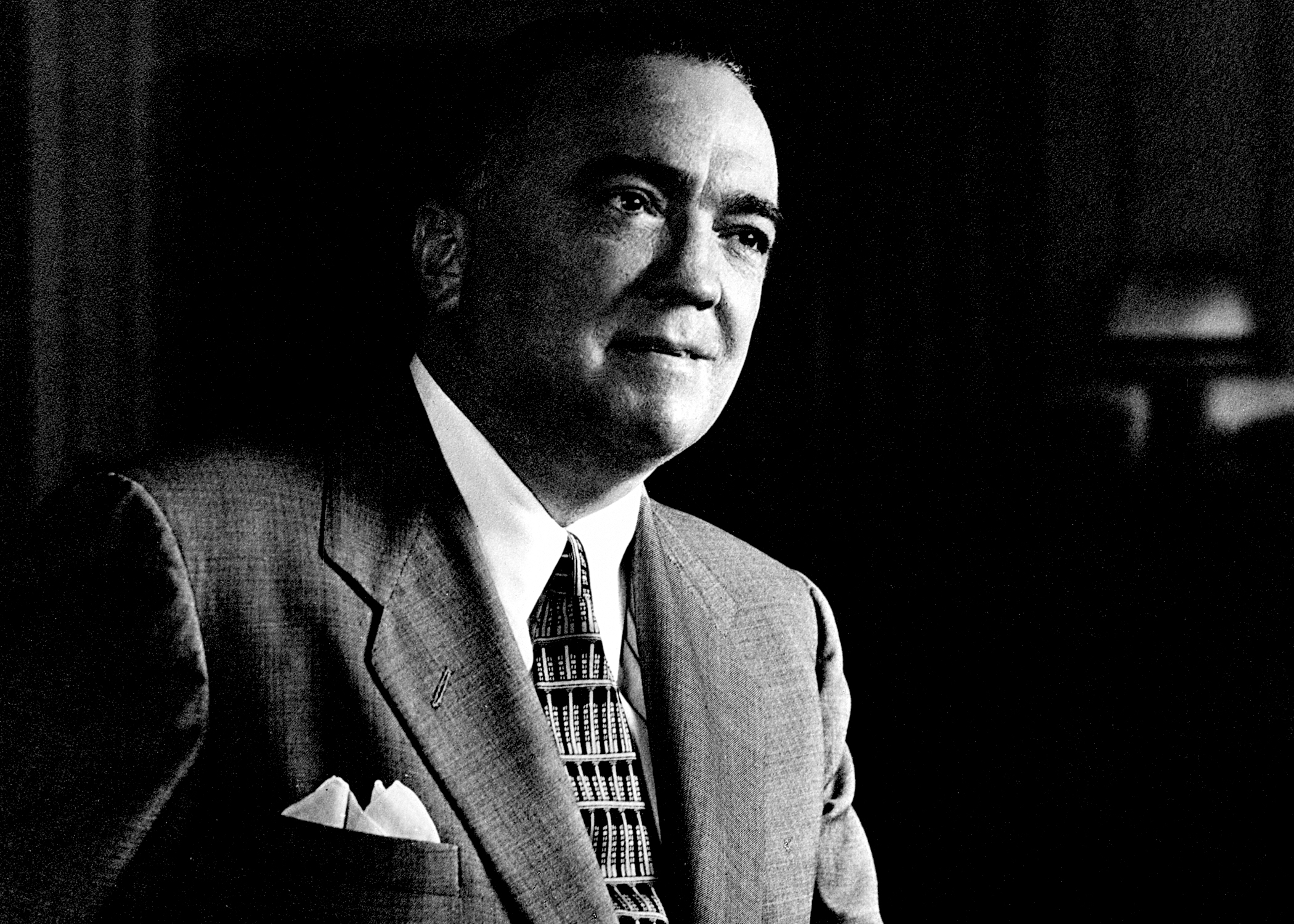
FBI Director J. Edgar Hoover in 1959. (Wikimedia Commons)
Eventually, the director’s obsession grew into a fear of what he labeled the rise of a Black Messiah; a leader who would galvanize the race issue to the point that he could threaten the entire American political establishment. Paul Robeson was not in any way a Black Messiah. Yet Hoover tapped Robeson’s phone, opened his mail, got his concert engagements canceled, and attempted to find sexual blackmail on the singer/actor.
All of these illicit and unethical activities were done under a veil of secrecy; simultaneously, according to Hoover biographer Curt Gentry, using FBI media assets to smear Hoover’s targets.
The Southern Christian Leadership Conference
In the book J Edgar Hoover: The Man and the Secrets, Gentry says the FBI director opened files on King in 1957, shortly after the success of the Montgomery bus boycott. The bureau’s goal was to find an association with either communists or communist sympathizers. In Racial Matters, O’Reilly writes that Hoover’s grand ambition was to tie King’s organization, the Southern Christian Leadership Conference (SCLC), to Moscow, thereby discrediting King, the SCLC and its allies.
Pollard’s documentary film MLK/FBI focuses on King’s association with his friend and colleague Stanley Levison. Levison was an attorney and businessman. He raised funds for the SCLC, offered legal advice, drafted speeches, and edited King’s first book Stride Toward Freedom.
 Levison was never really a communist, although he did support some of their causes, like sparing the lives of Julius and Ethel Rosenberg, who were controversially convicted of espionage for the Soviet Union and executed. But another supporter, Jack O’Dell had been a member, even though he had left the party years earlier. O’Dell worked out of the SCLC New York office.
Levison was never really a communist, although he did support some of their causes, like sparing the lives of Julius and Ethel Rosenberg, who were controversially convicted of espionage for the Soviet Union and executed. But another supporter, Jack O’Dell had been a member, even though he had left the party years earlier. O’Dell worked out of the SCLC New York office.
Because he was so influential with King, Hoover thought Levison should be their main target. When Levison suggested O’Dell become King’s personal assistant in Atlanta, Hoover took this as proof of the Moscow plot. In 1962, Hoover decided to go full bore against King and the SCLC, using his stooges in the mainstream press. O’Dell was placed on suspension.
In early 1963, Hoover truly feared the upcoming March on Washington that August. He also resented the White House for getting behind the demonstration. The Kennedy brothers were doing much more than Eisenhower had done on civil rights. They were supporting the Brown v. Board of Education decision and working to strike down Jim Crow in the South.
So, Hoover devised another way to use these communist suspicions about Levison and O’Dell. He would weaponize the reports to drive a wedge between King and the Kennedys.
Hoover inundated both the White House and the Justice Department with a steady stream of paper insinuating King was under the influence of communists, and that both O’Dell and Levison were active in CPUSA activities, according to Gentry’s biography of Hoover.
President Kennedy, in a walk with King in the Rose Garden, warned King about Hoover’s surveillance and his tactics, and how this threatened both of them. King ultimately terminated O’Dell and said he would freeze out Levison.
Wiretapping King
After the success of the March on Washington, Hoover discovered that King still had ties to Levison. Hoover now asked Attorney General Robert F. Kennedy to approve a wiretap on King. He sought this permission even though, as authors such as Harris Wofford and Curt Gentry have shown, Hoover had already been tapping King since the late 1950s. Hoover had authorized over 20 secret “black bag jobs” — breaking and enterings — against the SCLC prior to 1963. He was now enlisting the attorney general to give him an official cover.
RFK approved a tap against the Atlanta SCLC office for a period of 30 days, after which he would review the results, and if nothing was there, discontinue it. This was on Oct. 21, 1963. We all know what happened one month later.
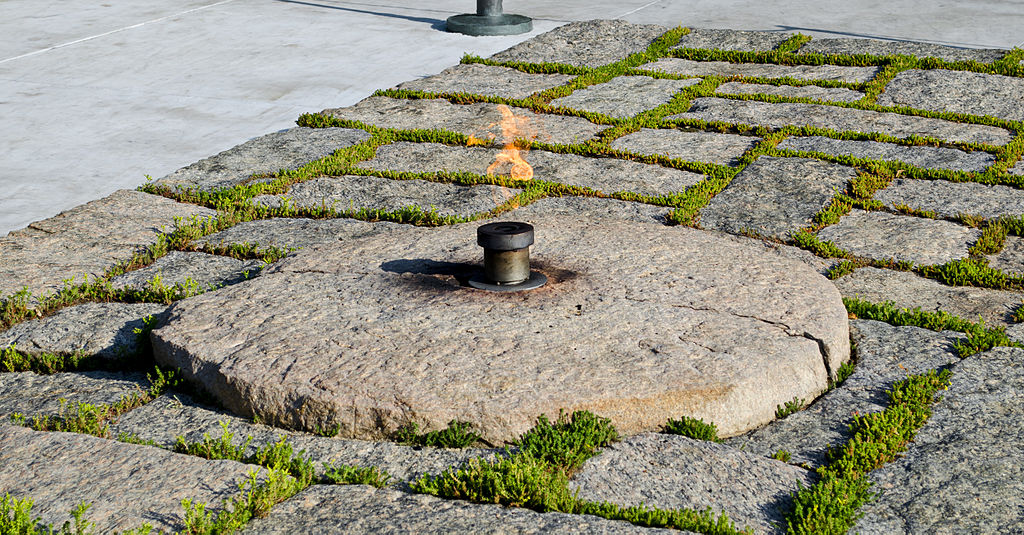
The eternal flame at the John F. Kennedy grave site in Arlington National Cemetery. (Tim Evason/Wikimedia Commons)
As the film shows, with his friend Lyndon Johnson in the White House, Hoover’s campaign against King moved into another gear. Whereas JFK’s Attorney General Bobby Kennedy had demanded that a negative dossier on King assembled by Hoover be withdrawn from government offices, Hoover now attacked King in public, calling him a notorious liar.
King tried to fight back, saying that Hoover and the FBI were lax in their investigations of crimes by white racists. At the signing of President Kennedy’s Civil Rights Act in 1964, Johnson invited Hoover to sit near the front row during the ceremony. This is around the same time that the FBI sent the infamous “sex tape” of King in a hotel room to the SCLC Atlanta office. There was a threatening note enclosed saying King would soon be exposed as a philanderer. Therefore, if he knew what was best for him, he should kill himself.
King briefly spoke out against Johnson’s escalation of the Vietnam War in 1965. He was then scolded by other civil rights leaders since a split on Vietnam could endanger their standing with the White House.
But in 1967 King saw a photo essay in Ramparts magazine. Entitled “The Children of Vietnam,” it depicted the indiscriminate bombing and napalming of civilians. King now began to attack the administration over the war. His famous speech at Riverside Church in New York in 1967 now made him a target of not just Hoover and Johnson, but of an editorial in The New York Times and one in The Washington Post.
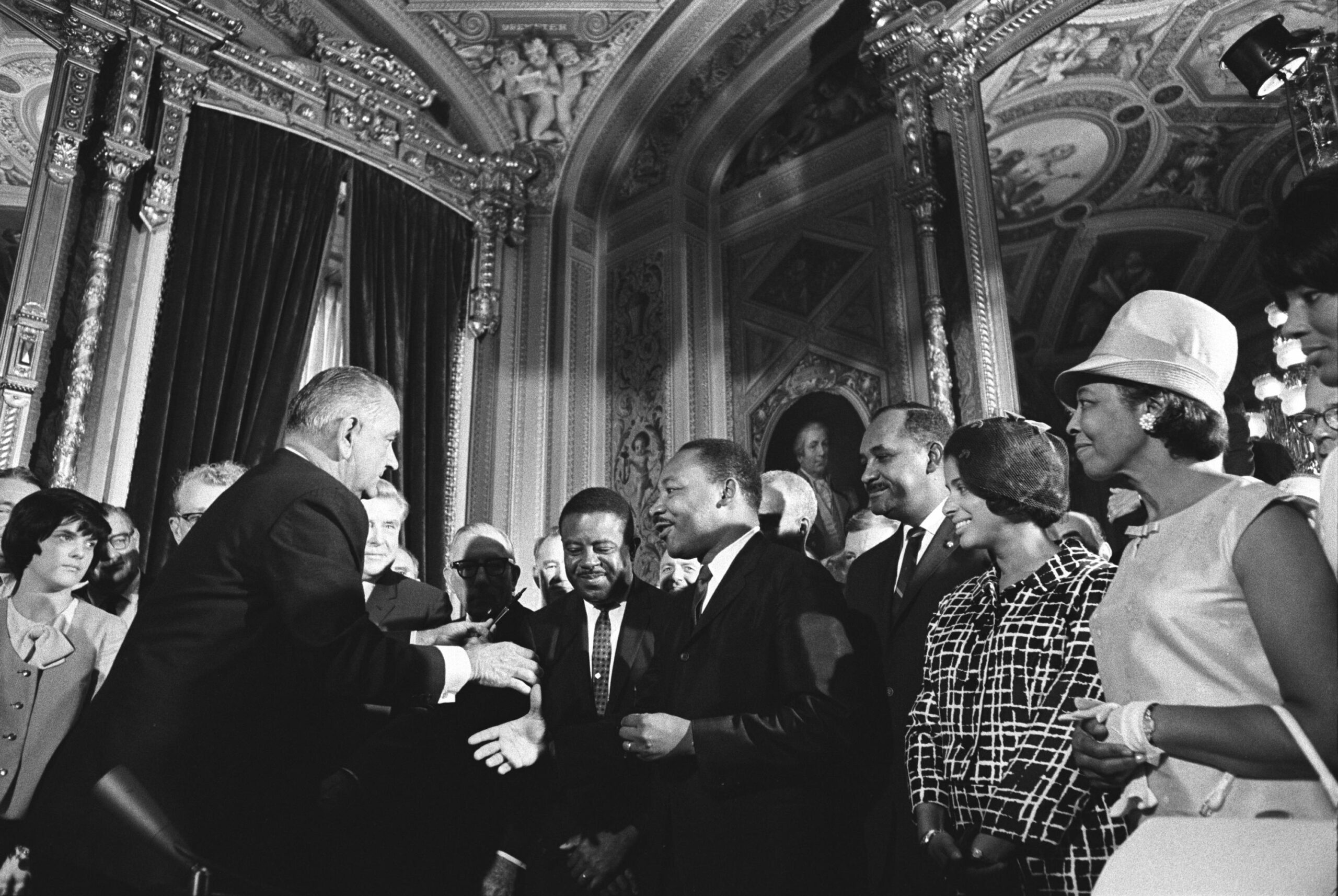
President Lyndon B. Johnson shaking hands with Martin Luther King Jr. at the signing of the Voting Rights Act on Aug. 6, 1965. (Yoichi Okamoto, LBJ Library, Wikimedia Commons)
Hoover had enlisted two informants on King. One was photographer Ernest Withers. The other, according to David Garrow in The FBI and Martin Luther King Jr., was office employee Jim Harrison. As King now began to expand his focus to Vietnam and poverty, Hoover began to ramp up COINTELPRO (counter intelligence program) operations against both civil rights groups and leftist press and organizations like the Students for a Democratic Society, or SDS.
These entailed the employment of not just spies, but agent provocateurs inside these organizations. And as King now began to arrange his Poor People’s Campaign, the FBI “discovered” that King was present at the rape of a parishioner, and he looked on and laughed. As one of the commentators in the film notes, if this was just an audio tape, how could the agents know King was “looking on.”
As the film depicts, after King’s assassination, rioting, looting and burning took place in over a hundred American cities. To the film’s credit, Andrew Young states that the accused killer, James Earl Ray, had nothing to do with the crime.
But the film also says that Hoover did a crackerjack job investigating King’s assassination. This leaves out two important points.
No. 1 In late March, the FBI prepared a memorandum saying that King has stayed at the Holiday Inn previously in Memphis. On King’s return, the SCLC booked a room at the African American-owned Lorraine Hotel. But before he arrived, someone — to this day no one knows who it was — changed the location of the room. This made it possible for King to be shot from his balcony facing the street.
No. 2 Another conclusion in MLK/FBI is that the FBI is not a renegade organization, that it is really part of the establishment. Perhaps this is so, but not under Hoover. The case of Fred Hampton pretty much demonstrates it was a renegade organization against African Americans.
The Black Panthers & Fred Hampton
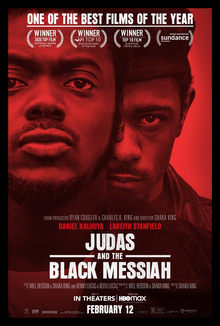 The Black Panther Party began in 1966 in Oakland under Bobby Seale and Huey Newton. In its gun-toting militancy it really owed more to Malcolm X than King. The Panthers carried guns in order to check instances of police brutality — they called it “cop watching.”
The Black Panther Party began in 1966 in Oakland under Bobby Seale and Huey Newton. In its gun-toting militancy it really owed more to Malcolm X than King. The Panthers carried guns in order to check instances of police brutality — they called it “cop watching.”
In direct response to this, the next year, Governor Ronald Reagan and the California legislature struck down the state’s open carry law. In October of 1967, Newton was wounded and a police officer killed in a gun battle.
These kinds of incidents — the opposite of King’s non-violent approach — spurred recruitment of new members and the opening of new chapters nationwide. As did a famous picture of Newton sitting in a wicker chair with a rifle and a spear. At its peak in 1970, there were 68 local chapters and thousands of members. But the Panthers also offered free breakfast programs, the opening of health clinics and political education classes.
All of the above did not sit well with Hoover. In 1969 he labeled the Panthers “the greatest threat to the internal security of the country.” He called for an extensive COINTELPRO program to neutralize them.
William Sullivan, the man directing these activities, said the Panthers were the black equivalent of the Klan, according to O’Reilly’s book Racial Matters. Anyone in the bureau who resisted that characterization, and the programs Sullivan arranged, was given an ultimatum and a deadline. Charles Bates of the San Francisco office initially resisted and Sullivan gave him two weeks to change his mind. He decided to go along for the sake of his career. The COINTELPRO began in the San Francisco/Oakland area.
Hoover’s campaign against the Panthers was probably the most extensive, violent, and relentless counter-intelligence program the FBI ever devised. It consisted of surveillance, infiltrations, agent provocateurs, police perjury, ersatz threatening letters and other techniques. In addition to that, the bureau reached out to other law enforcement organizations in order to multiply the effect and to disguise the bureau’s own role in what would eventually become the destruction of the Panthers. There is probably no better example of this than the assassination of Fred Hampton.
Hampton began his career as an effective community organizer for the NAACP. Attracted by the more radical approach of the Panthers, Hampton decided to join the Chicago branch.
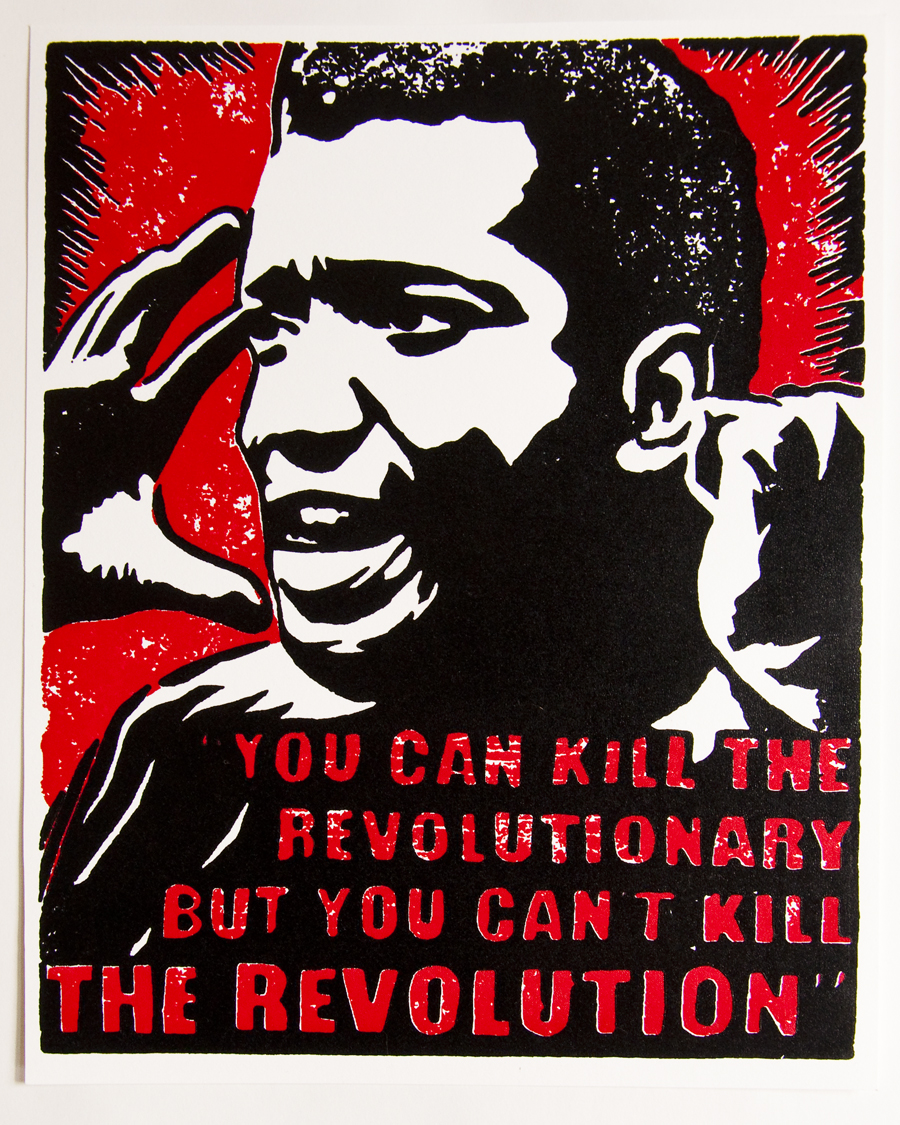
Fred Hampton poster. (Jacob Anikulapo, Flickr, CC BY-NC-SA 2.0)
According to then Attorney General Ramsey Clark, Hoover was aware of Hampton before anyone else in government was. Hampton was a dynamic speaker, with a forceful yet malleable personality. He was an imaginative and innovative organizer. One of his most notable achievements — depicted in the new film Judas and the Black Messiah — was his attempt to incorporate street gangs into the Panthers so they would not feud with each other. He also tried to make this coalition multi-racial, including Hispanics, Native Americans and the white working class. He named it the Rainbow Coalition. He was so effective that he became the Panthers’ state chairman and at the time of his death, he was about to be appointed to chief of staff for the national organization.
The film depicts the police planting an informant in Hampton’s office. William O’Neal had raided bars impersonating an FBI officer. Once the unsuspecting clientele turned over their wallets and keys, he would steal a car. Eventually caught, the FBI threatened to send him to prison for about six years. O’Neal decided to become a combination informant/provocateur on Hampton for his Bureau control agent, Roy Mitchell.
O’Neal helped set up a raid at the Panther’s Chicago headquarters that resulted in eight arrests. A later raid at Panther headquarters, as depicted in the film, turned into a shootout. When the occupants surrendered, the police went in and torched one floor of the building. During a Nov. 13, 1969, gun battle on the South Side of Chicago, two policemen and one Panther were killed.
The police and FBI were so desperate to put Hampton away, that they charged him for stealing $71 worth of ice cream bars. He was convicted for this and received a two-to-five-year sentence. His attorneys had him temporarily released. Even though Hampton had been ordered back to prison, Mitchell asked O’Neal for a floor plan of Hampton’s apartment that indicated where Hampton slept.
At about 4:30 AM on Dec. 4, 1969, 14 policemen detailed to the Cook County State Attorney’s office executed a raid for weapons. The police had 27 guns, five shotguns, and one machine gun. The lead cop was James Davis, an African American who had a reputation for brutalizing black suspects.
Hampton had been drugged by O’Neal with secobarbital. He did not wake up during the fusillade. Davis broke down the door and shot Panther Mark Clark through the heart. As Clark fell dead, he discharged his weapon into the floor. That was the only shot fired by a Panther. The police fired over 90. Four other occupants of the apartment were wounded.
As noted above, the pattern of the fatal bullets into Hampton were at close range and into his forehead and temple. The Cook County attorney in charge of the assault, Edward Hanrahan, had agreed to conceal the FBI’s role in the illegal raid. The pretext was the Panthers had illegal guns; it turned out the guns were all legally purchased and registered.
Shaka King has directed the film in a workmanlike manner. He lays the story out clearly and does not draw attention to himself. The script, by King and Will Berson, is as accurate as one will find in a historical film. It uses the latest information garnered by attorneys Flint Taylor, Jeff Haas and historian Aaron Leonard to implicate Hoover directly in the activities of Mitchell and O’Neal. Daniel Kaluuya plays Hampton. His portrayal is fine until you watch film of the real Hampton. Imagine a young Samuel Jackson in the role.
Both these films are worth seeing. It’s rare to see Hollywood treat a serious subject seriously. America is still recovering from the reign of J. Edgar Hoover. The legendary lawman once said, “Justice is incidental to law and order.” The results of that motto are found in these films.
James DiEugenio is a researcher and writer on the assassination of President John F. Kennedy and other mysteries of that era. His most recent book is The JFK Assassination : The Evidence Today.
The views expressed are solely those of the author and may or may not reflect those of Consortium News.



I will stand by what I said about JJA owning J Edgar. J. Edgar never was close to standing up to JJA.
Recent discoveries, many from newly released documents that aid tying up some loose ends are very revealing.
George Efthron Joannides was called out of retirement to manage the team providing information from CIA to WC investigators. The reason is because the original investigator Helms appointed John Whitten was of the mind to find the Killer or killers being former CIA he was very adept at finding what he needed and wanted to run the investigation.
Enter Efthron. He was the filter CIA put in place. He shut down any and all information he didn’t approve of going to the WC and Richard Helms had his back at the time.
So yes I agree, it is more than likely that JJA, Helms and Joannides shut any FBI involvement of significance and likely monitored FBI actions.
It is little secret that Helms lied to the Church Committee repeatedly about CIA activities and anything that the committee could have used to target CIA.
CIA was playing dirty pool with Judo in the clenches.
But no one should take my word for it and if one is truly interested in the Kennedy murder they simply need to be patient a little while longer.
I’ll see ya in the funny papers.
One thing everyone should bank on as being true is the relationship between Hoover, Hoover’s FBI and the CIA.
No one should underestimate the control CIA had over the Bureau, as in ” pretty much total “, on a given issue.
James J Angleton tolerated Hoover because he owned him & his FBI lock stock and barrel and used him & his FBI accordingly. Never underestimate CIA influence on Hoover and his FBI. They were CIA assets.
CIA desired turmoil and chaos and made damned sure they got it. This one of their cherished sources and methods. Spreading hate and discontent.
Thanks CN
Hoover had a falling out with the CIA during the Kennedy assassination inquiry. He felt that Yuri Nosenko was genuine. He also thought that the CIA was lying about Oswald being in Mexico City.
Therefore, the liaisons were cut back and in some cases halted. There is a good book on this called Wedge, by Mark Reibling.
I have a question. Would you happen to know anything about the FBI investigation in Salmon Shapiro’s NUMEC? CIA and FBI danced with the Devil in a pale blue light to advance the Israeli nuclear program and so far everyone involved has gotten away with it, to the point of many earning all sorts of awards for doing so evidently. Angelton had to have known about itl
What I understand is that CIA interfered with FBI investigations by refusing to turn over evidence. The FBI did little in the way of protesting CIA actions. Essentially turning their heads to look away.
I have also found in John Kerry’s special investigation into world drug trade CIA again with held help.
Hoover was right about CIA’s lying about Oswald. CIA had been tracking Oswald since his defection to Russia , well before Nov 22, 1963. They lied about all of the history CIA’s tracking of Oswald. Still are.
The fact is that J.J. Angelton had a photo of Hoover and his male lover. Not that we could find it now.
Generally a good analysis of the FBI’s sordid history of subversion.
What needs to said is that Eisenhower had in fact, done quite a lot for Civil Rights during his administration. While his work was mostly behind the scenes, he did appoint Earl Warren as Chief Justice, and in 1959 the US Civil Rights Commission published the first comprehensive report on Black Inequality. Ike’s Civil Rights Act of 1957, while watered down, was nevertheless the first of its kind since Reconstruction, preparing the ground for later Civil Rights legislation.
Also, the FBI continued its programs of infiltration and disruption in the years after the 1960s and to the present day. The disruption of Anti War, Environmental, and other reform minded activist groups were ramped up during the 1980s under Reagan /Bush and even further expanded after 9/11. Which does bring many questions about just who and what was behind provoking the riots of this last summer and this January.
Finally, the role of J. Edgar Hoover and the JFK assassination is a subject little talked about.
That Kennedy and his brother had decided to retire Hoover when he reached the mandatory age of 70, ( A documented fact), and with Hoover backed into a corner fighting to keep his power , and his proven record of going outside the law, does make one wonder about just how far Hoover would have gone to protect himself. Its also interesting that after JFK’s death, Lyndon Johnson exempted Hoover from retirement, and made his position semi-permanent, subject to annual renewal by the President.
It is true that Eisenhower appointed Warren to the Supreme Court. But as many historians have noted, Ike tried to talk Warren out of voting for Brown vs Board. After that, the White House did not enforce that decision. For example, in the Autherine Lucy case at Alabama in 1956, that was an NAACP lawsuit based on Brown that got her admitted. In the name of states rights, Eisenhower did not protect her, and allowed her to be run off campus. In 1957, in another case based on Brown, Ike allowed the Jim Crow governor of Arkansas, Orval Faubus, to send in the National Guard to protect the rioters and allow them to taunt and terrorize the nine students the court had allowed to enter Central High. Then, after conferring with the governor, Ike thought Faubus would now follow the court order. He did not. He completely removed the Guard, allowing the students to be taunted and terrorized again. Only then, after three weeks of chaos with Faubus humiliating him, did Ike send in troops. He had no choice. After this he tried to salvage some grace by sending up a bill to set up an advisory commission on civil rights. It was really designed to split the Democrats, northern liberals vs southern conservatives. Majority leader LBJ watered it down so much to guarantee passage that Senator Kennedy did not even want to vote for it; Johnson had to lobby him to do so. As the legal counsel of that Commission, Harris Wofford, later wrote, since it was advisory, they had to send requests to the White House. Virtually all of them were turned down.
This changed significantly under the Kennedy administration. Senator Kennedy had twice said in public that he would support the Brown decision. In May of 1961, Bobby Kennedy, the AG, devoted half his speech at the University of Georgia Law Day to saying he would do so. In 1961, RFK indicted the Secretary of Education in Louisiana for refusing to obey a court order based on Brown. In 1962, and ’63, RFK cooperated with the NAACP to integrate Ole Miss and Alabama. In those cases, he sent in marshals and troops to protect respectively James Meredith, and Vivian Malone and Jim Hood BEFORE they entered the campus. He then had them escorted with marshals to and from classes for weeks on end to make sure they would not be run off campus. And in 1963, when JFK submitted his omnibus civil rights bill, Eisenhower spoke out against it from retirement in Gettysburg.
In my view, Eisenhower and Nixon had real opportunities to do something with civil rights. They did little or nothing. This left a big mess for JFK. We all know that later, when he became president, Nixon used the issue to implement the Southern Strategy.
“Another conclusion in MLK/FBI is that the FBI is not a renegade organization, that it is really part of the establishment.
Perhaps this is so, but not under Hoover. The case of Fred Hampton pretty much demonstrates
it was a renegade organization against African Americans.”
— The idea that Hoover was not integral to the establishment, albeit acting on behalf of extreme currents of it, is ludicrous.
Hoover had the full weight and power of the establishment at his disposal; it wasn’t by accident.
Eric:
Hoover did these COINTELPRO operations in secret. They were unlawful.
They were condemned by the Church Committee.
Great reviews by James DiEugenio. I would add that according to MLK attorney William Pepper’s book “ Enemy of the State “ , Jessie Jackson was an informant for the FBI in King’s entourage and downstairs away from the balcony at the time of King’s assassination. Jessie Jackson also became the head of Fred Hampton’s Rainbow Coalition. Run Jessie run but you can’t hide anymore, you’ve been outed for the “Judas” that you are.
I’ve read that Jesse Jackson made the arrangements for King to be moved to an outside room.
Communism was really never a danger to America, but they did need an enemy in order for what became known as the MIC, so they could endlessly steal the working class monies and now they are busy stealing their freedoms.!!
And thus history goes we always lose the best while evil survives.!!1
Looks like the DNC is following along with this trend with Russia, Russia, Russia
accusations, totally without any real evidence. Fighting Communism even after
Communism is gone.